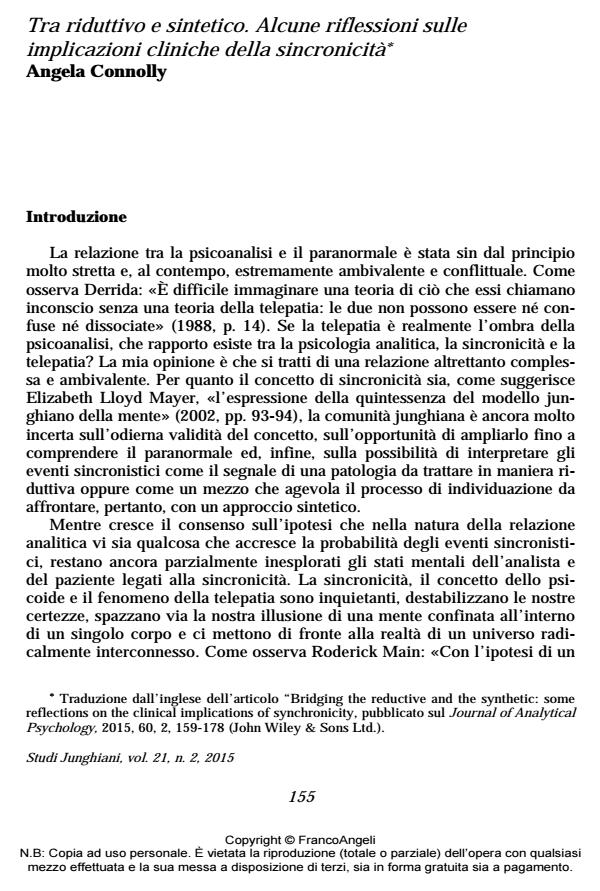Bridging the reductive and the synthetic: some reflections on the clinical implications of synchronicity
Journal title STUDI JUNGHIANI
Author/s Angela Connolly
Publishing Year 2016 Issue 2015/42
Language Italian Pages 21 P. 155-175 File size 107 KB
DOI 10.3280/JUN2015-042009
DOI is like a bar code for intellectual property: to have more infomation
click here
Below, you can see the article first page
If you want to buy this article in PDF format, you can do it, following the instructions to buy download credits

FrancoAngeli is member of Publishers International Linking Association, Inc (PILA), a not-for-profit association which run the CrossRef service enabling links to and from online scholarly content.
More than 60 years have passed since Jung wrote his groundbreaking paper on synchronicity and the psychoid unconscious, and while we are ever more aware that there is something in the analytical relationship that predisposes to synchronistic events, we are still unable to define exactly what we mean when we talk about synchronicity, just as we are still relatively uncertain as to the exact states of mind in analyst and patient that predispose to these occurrences and the meaning we should attribute to them. If, through our training and our clinical practice we are expected to be thoroughly grounded in the models of mind of either Freud or Jung, as Lloyd Mayer writes, To be thoroughly grounded in both something very few of us are - may suggest a route towards engaging the question of how the individual boundaried mind and the radically connected mind describe models of mind that can start to complement each other in new and critically important ways. In the same way, in China on the Mind, Christopher Bollas distinguishes between two different states of mind: one dominated by the paternal order which is causal, metonymic, diachronic, representational (privileging content over form) and dependent on words; and one under the sway of the maternal order which is metaphoric, synchronic, presentational (privileging form over content) and dependent on image. If, as Bollas writes, ‘the maternal order has been subjected to an ongoing repression within the psychoanalytical movement’ (ibid, p. 29), equally we could say that the repressed or shadow side of analytical psychology is the paternal order. I think that the image of the neglected and dying father in the first episode I mention above speaks also to this and to the need on the part of both psychoanalysis and analytical psychology to mediate and integrate these two opposite states of mind. By looking at the different states of mind that are involved in synchronicities, the hope is that we can begin to create bridges between the reductive and the synthetic approaches to the psyche.
Keywords: Telepathy, sunchronicity, causality and acausality, role of acategorial and non-categorial states of mind in synchronicity, reverie
- Imaginatio alchemica e nessi acausali versus terzo analitico intersoggettivo nella spiegazione dei fenomeni sincronici Stefano Fissi, in STUDI JUNGHIANI 59/2024 pp.47
DOI: 10.3280/jun59-2024oa18133
Angela Connolly, Tra riduttivo e sintetico. Alcune riflessioni sulle implicazioni cliniche della sincronicità in "STUDI JUNGHIANI" 42/2015, pp 155-175, DOI: 10.3280/JUN2015-042009